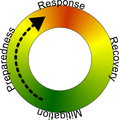Managing a Disaster - Four phases of success (Recovery)
By Jamey PerkinsDownload this article in Adobe Acrobat Reader
Disaster Recovery
Disaster recovery involves setting in place the results of mitigation, response, and preparatory efforts, in that its outcome is often ultimately based on the effectiveness of the previous. If one thinks of recovery as a simple cleanup effort designed to restore an area to its previous existence, they would be failing to consider the permanent and long standing repercussions associated with those efforts.

Let's first draw attention to a basic recovery scenario. On March 24, 1989, the Exxon Valdez oil tanker collided with Bligh Reef. The collision caused the spill of 10.8 million gallons of the ships 53.1 million gallon cargo which eventually covered 11,000 square miles of sea. The result led to the largest and most expensive oil spill recovery effort in history, and was led by the US Coast Guard.
After an investigation by the National Traffic Safety Board, both the Exxon Shipping Company and the United States Coast Guard were at fault for the accident. Exxon's fault lay on the improper navigation of the vessel and the possibility of the ship master being under the influence of alcohol. The blame on the US Coast Guard lay upon the failure to provide an effective vessel traffic system.
Twenty years after the event, scientists are still studying the effects. The destruction to coastal areas and to wildlife has exceeded all early expectations, and as of 2007 it is estimated that more than 26,000 gallons of oil still remains embedded in the soil of the coastal areas.
Although the basic cleanup of the oil was mostly successful, the fallout damage associated by the spill is irreparable. The ecological effects from loss of microorganisms and wildlife in the area are still yet to be determined, and the costs associated with trying to repair the damage are still continuing to grow.
Conclusion - Had proper mitigation, preparatory, and response systems been in place, the recovery efforts would have been minimal in comparison. Appropriate precautions, both by Exxon and by the US Coast guard, could have not only prevented the accident, but also could have made the cleanup effort more successful and with a much more reduced number of wildlife casualties and minimal destruction of environmental surroundings.
In general, the recovery effort of any disaster or emergency scene can begin once all threats to life have been resolved. It is important to start this process as quickly as possible to reduce the chance of long lasting effects caused by the crisis. It is also during this phase of a crisis that important mitigation measures can also begin to take shape. By documenting efforts and resources needed to accomplish the recovery, it makes it possible to better plan for any future incidents.
Disaster recovery can involve all levels of government and local organizations. The size of the recovery effort is determined by the resources needed, and the assistance available. While a great deal of any recovery assistance will come in the form of local donations of money, supplies, and workforce, there is also a substantial supply of federal assistance available. Some of that assistance is:
- The Individuals and Households Program (IHP)
- Disaster Unemployment Assistance (DUA)
- Disaster Relief Employment Assistance
- Public Safety Officers’ Benefits Program
- Public Safety Officers’ Educational Assistance Program
- Crisis Counseling
- Tax Relief
- Public Assistance (PA)
- Reimbursement for Firefighting on Federal Property
- Fire Management Assistance Grant Program
- Economic Injury Disaster Loans
- Emergency Loans for Farms – (EM) Loans
- Other General Assistance Programs with eligibility requirements.
Another resource for Federal Assistance is the Catalog of Federal Domestic Assistance with over 1600 available programs listed.
Read the rest of the article
- What is a disaster
- The evolution of man and nature as a direct result of disaster
- Managing a Disaster - Four phases of success (Mitigation)
- Managing a Disaster - Four phases of success (Preparation)
- Managing a Disaster - Four phases of success (Responding)
- Managing a Disaster - Four phases of success (Recovery)
- Disaster Management - An organized structure in the midst of a chaotic event
- Disaster - An inevitable future

